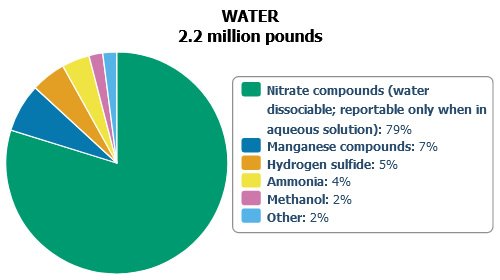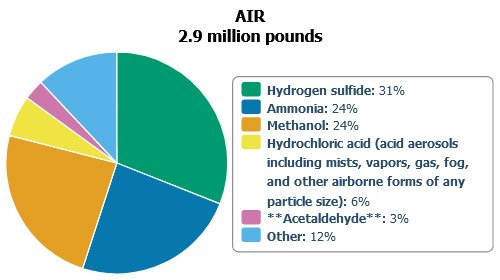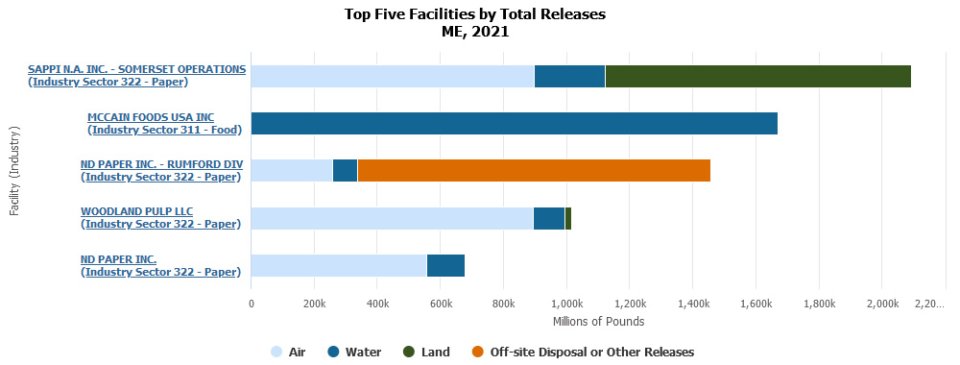BOSTON (March 16, 2023) – Today, the U.S. Environmental Protection Agency (EPA) released its 2021 Toxics Release Inventory (TRI) National Analysis, which shows that environmental releases of TRI chemicals from facilities covered by the program remained below pre-pandemic levels and releases in 2021 are 10% lower than 2012 releases, even with an 8% increase from 2020 to 2021. Additionally, in 2021, facilities managed 89% of their TRI chemical waste through preferred practices such as recycling, energy recovery and treatment, while reporting that they released 11% of their TRI chemical waste into the environment.
In Maine, the reporting data show that overall releases of pollutants to the environment decreased since the previous reporting year (2020). Additionally, over the last 10 years, Maine has reduced air emissions 34%, due to paper mill air emission reductions and reduced production from paper mills.
TRI tracks the management of certain toxic chemicals that may pose a threat to human health and the environment. U.S. facilities in different industry sectors must report annually how much of each chemical is released to the environment and/or managed through recycling, energy recovery and treatment. A "release" of a chemical means that it is emitted to the air, water or placed in some type of land disposal.
"TRI reporting is a key part of EPA's efforts to provide greater access to vital environmental information to Americans about their neighborhoods," said EPA New England Regional Administrator David W. Cash. "Making this information publicly available also incentivizes companies to reduce pollution and gives communities tools to act locally – which is particularly important for underserved communities that have historically been disproportionately impacted by pollution."
Maine: Released on and offsite
During 2021, the latest year for which data is available, 79 facilities reported approximately 7.4 million pounds were released onsite to the air, water and land (such as landfills), compared to 5.9 million pounds released in 2020 (an increase of 1.5 million pounds). Approximately 2.9 million pounds were released to the air and 2.2 million pounds were released to surface water. The major pollutants released to the air were hydrogen sulfide at 31% and ammonia with 27% of all air releases in the state. The major pollutant released to the water was nitrate compounds (at 79% of all releases to water) which can promote algal growth in surface waters. From 2012, on-site and off-site releases decreased from 12 million pounds in 2012 to 7.4 million pounds in 2021.
Maine: Total Production Related Waste
During 2021, 79 facilities reported approximately 51.1 million pounds of total production related waste was managed compared to 79 facilities and 53.8 million pounds managed in 2020 (a decrease of 2.7 million pounds). Total production related waste includes chemicals released directly to the environment and wastes that are treated (such as in an incinerator or wastewater treatment system), recycled and waste that is landfilled.
Maine: Top Five Companies
The companies in Maine with the greatest releases included four paper mills and one food processor, and while the order of top the top five releases changed over the last ten years, they remail the same five companies. These 5 facilities produce d 92% of the releases in the state of Maine.
Each year, EPA makes publicly available TRI data reported by industries throughout the United States regarding chemical releases to air, water and land by power plants, manufacturers and other facilities which employ ten or more workers, and which exceed thresholds for chemicals. Reporting includes information on chemicals released at a company's facility, as well as those transported to disposal facilities off site. TRI data do not reflect the relative toxicity of the chemicals emitted or potential exposure to people living in a community with reported releases.
Reporting under TRI does not indicate illegal discharges of pollutants to the environment. EPA works closely with states to provide regulatory oversight of facilities that generate pollution to the nation's air, land and water. Effective review and permitting programs work to ensure that the public and the environment are not subjected to unhealthful levels of pollution, even as agencies work to further reduce emissions of chemicals to the environment. Enforcement efforts by EPA and states ensure that facilities that violate their environmental permits are subject to penalties and corrective action. Yearly releases by individual facilities can vary due to factors such as power outages, production variability, lulls in the business cycle, etc., that do not reflect a facility's pollution prevention program(s).
The top five chemicals released to surface water in Maine during 2021:

The top five chemicals released to the air in Maine during 2021:

Companies with the largest releases:

TRI data are submitted annually to EPA, states, and tribes by facilities in industry sectors such as manufacturing, metal mining, electric utilities, and commercial hazardous waste. Under the Emergency Planning and Community Right-to-Know Act (EPCRA), facilities must report their toxic chemical releases for the prior year to EPA by July 1 of each year. The Pollution Prevention Act of 1990 also requires facilities to submit information on pollution prevention and other waste management activities related to TRI chemicals.
The 2021 Analysis features updated visualizations and analytical tools to make data more useful and accessible to communities, including the option to view data by region and watershed. EPA has also updated demographic information in the "Where You Live" mapping tool and in the Chemical Profiles section. Readers can view facility locations with overlayed demographic data to identify potential exposure to TRI chemical releases in vulnerable communities. Community groups, policymakers, and other stakeholders can use this data, along with other environmental data, to better understand which communities may experience a disproportionate pollution burden and take action at the local level.
PFAS Reporting
For the second time, the TRI National Analysis includes reporting on perfluoroalkyl substances (PFAS) following the 2020 National Defense Authorization Act. For Reporting Year 2021, 176 PFAS were reportable to TRI. Facilities reported managing 1.3 million pounds of these chemicals as waste. This is an increase from the 800,000 pounds in 2020 and is largely due to reporting on one PFAS, perfluorooctyl iodide, which EPA began requiring facilities to report in 2021. Most of the facilities that manage PFAS operate in the chemical manufacturing and hazardous waste management sectors. The hazardous waste management sector accounted for roughly 80% of the 108,334 pounds of PFAS released into the environment, primarily to regulated landfills.
Last December, EPA proposed a rule that would improve reporting on PFAS to TRI by eliminating an exemption that allows facilities to avoid reporting information on PFAS when those chemicals are used in small, or de minimis, concentrations. Because PFAS are used at low concentrations in many products, this rule would ensure covered industry sectors and federal facilities that make or use TRI-listed PFAS will no longer be able to rely on the de minimis exemption to avoid disclosing their PFAS releases and other waste management quantities for these chemicals.
More information:
Facility efforts to reduce toxic chemical releases
from EPA News Releases https://ift.tt/6oCQHzc
